Slipped disc symptoms
Lower back pain may be associated with a discomfort in the lower extremity, as it's called in anatomical jargon, and very occasionally in both limbs. Sharp stabs or a dull ache on sneezing, coughing and straining on the toilet is the hallmark of a disk injury.
Irritation in the thigh, and down to the foot, on bending forwards and perhaps when bending backwards, or to the side may also occur.
There are four degrees of a slipped disc. In the first three you will have low back pain, which may or may not be severe, and increasing discomfort in the leg. In grade four the lumbar stabs diminish dramatically, but the limb becomes far worse and is likely to become weak and numb.
The sciatic and femoral nerves emanate from the lumbar spine; the former from right at the bottom, and the latter from the mid lower back. They supply different parts of the limb.
Is that pain in your lower limb coming from your back, or something else? Have you a pulled a calf muscle, a tendonitis, a deep vein thrombosis, a partially blocked artery, or one of a heap of other conditions?
The test I use most frequently is called the Slump test, and you can do it at home, but interpreting the results is not straight forward. However, with a negative Slump test you more or less categorically rule out a pinched sciatic nerve in the back, but not a femoral nerve lesion.
It's rare for the pain to get straight to your leg, with no back pain first, but it can happen. Most uncommon.
Slipped disc symptoms
The four levels of slipped disc (disk) are:
Grade I: Low back pain only
In 60% of the patients with this condition, the pain starts after bending and twisting and, often, heavy lifting. For example lifting and moving a potted plant. Should you sneeze at just that moment, then your back is especially vulnerable.
The low back pain may be severe, or in fact relatively minor.
Grade I slipped disc symptoms are:
- Back Pain on bending forwards
- Pain with coughing, sneezing and/ or bearing down on the toilet, and laughing.
- Pain on sitting.
- Early mornings may be worst.
- It's possible that you may go into a strange posture. Stuck bending forwards, or to the side. The tower of Pisa sign. POSTERO LATERAL DISK HERNIATION ...
The normal disc is a sort of shock-absorber. Notice that the disc is made up of two parts:
- A central bubble of gel called the nucleus. Fluids cannot be compressed, so when you lift something, and there is increased weight on the disc, the forces are distributed in all directions. This is quite normal.
- The gel is contained in the annulus, ring. Notice that it consists of about 6 layers of fibre, arranged like an onion skin, but also interwoven with cross links.
Grade II: Low back pain + Leg pain
If the gel in the nucleus tears through more layers of the ring then the slipped disc symptoms will change: pain, or tingling, or a numb feeling, or a tight feeling starts to develop, first in the buttock, then radiating down the leg.
A tear through one or two layers is often called a bulging disc. It hasn't actually reached the nerve. But if it tears through more layers then tingling and pain in the leg will begin.
If whilst busy with some activity, usually involving twisting, and often bending, whilst applying pressure, and you feel a stab of pain in the lower back, immediately stop. Your back is warning you, and if you're lucky the damage is not yet done. Sometimes alas the fibres of the annulus have just torn further, and it's vital to prevent the gel from rupturing right through into the canal.
Take special note of which part of your leg is affected; it gives your chiropractor important extra information. Read more about patterns oftingling in feet and legs at the link below.
Notice now that the bulge, now called a protrusion, has reached the nerve; if it goes any further, then called a prolapse, sometimes known as an extrusion. These terms tend to be used rather loosely and interchangeably.
Notice now that the bulge, now called a protrusion, has reached the nerve; if it goes any further, then called a prolapse, sometimes known as an extrusion. These terms tend to be used rather loosely and interchangeably.
Perhaps more commonly, the nerve isn't actually pinched. The fixated joint prevents proper joint nutrition of the hyaline cartilage from occurring. As the cartilage is starved of nutrients and oxygen, it begins to release noxious toxic chemical, causing inflammation of the surrounding tissue, including the nerve root.
The result is radiating symptoms down the leg, the pattern according to which nerve is affected.
Tip @ Slipped disc symptoms
People often think the tightness in the back of the thigh is from a tight hamstring - and try stretching it by bending forwards. It's about the WORST thing you can do if you are having slipped disc symptoms!
DON'T!
Lower back pain? Tightness or pain in the back of ONE leg? Definitely not fine.
Grade III: Low back pain + leg pain + NEUROLOGICAL CHANGES
Whilst I don't believe one has to rush off to the doctor with every snivel, or to the chiropractic with every back pain, should pain, or a tight feeling, develop in the leg then I recommend you don't wait. Get to your chiropractor immediately. The sooner that disc is reduced the less the likelihood of it progressing.
Why? Untreated Grade 2 often develops neurological signs:
- First, increased response to a pinprick in the leg, later it becomes numb.
- A decreased reflex.
- Weakness, most often either difficulty raising the big toe, or standing on the heel.
Notice in this next picture - an MRI scan - how the gel is bulging deep into the Inter vertebral foramen? Now it's called a prolapse... aka as an extruded disc.
As these slipped disc symptoms progress, your life style will become more severely limited. Your Chiropractor will probably insist you stay at home, not sit at all, and probably spend some of the time lying down, and doing some lower back exercises ...
Sequestration or extrusion
Grade IV: Minimal back pain + severe pain in the leg.
Mr T is a very fit Dutch policeman. Four months ago after a fall on the beat, he developed the typical slipped disc symptoms. LBP, pain with sneezing and discomfort on bending.
NSAID drugs were prescribed by his doctor, but no reduction of the bulge was attempted; it was seen simply as an inflammation, rather than a change in the normal workings of the disc, what we call the biomechanics of the joint, nor was any rehabilitation attempted; the pain receded.
As part of his job, he often needs to travel long distances in the car, and within weeks he began developing back pain again, and worse, more severe slipped disc symptoms developed.
First pain in the leg, then weakness in the calf, and numbness on the side of his foot. Physiotherapy helped somewhat.
Abruptly, the stabs in his back subsided after a heavy shower of sneezes. Dutch is a very colourful language. And then the pain in his leg became very severe. Sitting in the car became quite impossible.
In a grade 4, a fragment of the disc gel becomes detached from the main body of the nucleus and becomes lodged in the spinal canal or foramen. Back pain is greatly reduced, but the leg becomes very uncomfortable; bladder symptoms may develop. In technical jargon, it's called thesequested disc; ouch.
Can you see the tiny loose fragment?
Can you see the tiny loose fragment?
This scan was only taken after he had already had four chiropractic adjustments, manipulations, of the slipped disc. By then the pain in his leg was already 30 percent less, so we will never know how large the bulge actually was in the beginning.
The Slipped Disc Symptoms of a Grade I or II herniation are treated by chiropractors on a daily basis. It's routine, though I've learned never to take a slipped disc for granted. Nor should you. Research shows that 5% of all those suffering acute lower back pain will go on to develop severe, disabling, chronic pain and no one knows ahead of time whether you could be in that 5%.
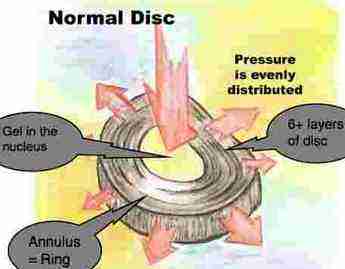
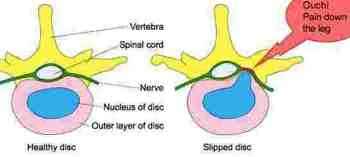
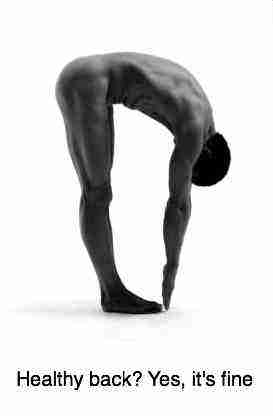
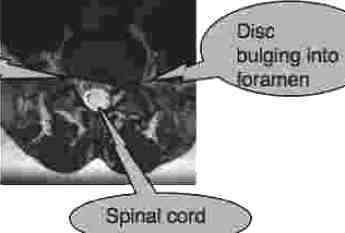
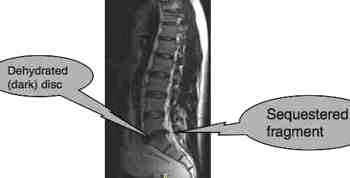
Nenhum comentário:
Postar um comentário